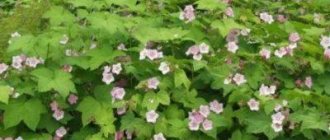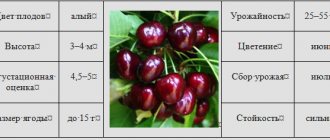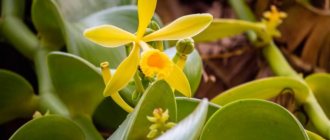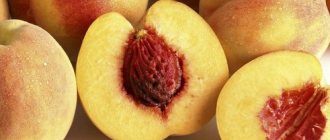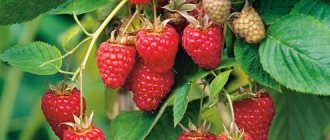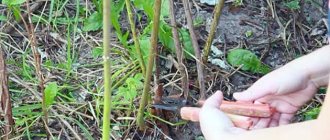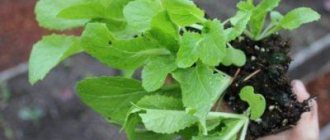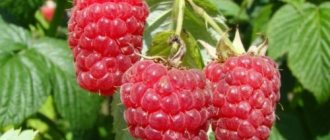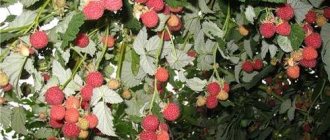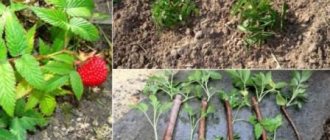Photo and description of raspberries “Reward”
“Reward” grows no more than 2 m. The average height is considered to be 1.5-1.7 m. The bush is spreading and produces a small number of shoots. Each of them is erect and flexible, but can break under the weight of the berries. Therefore, the shoots need to be tied to trellises or single supports.
Botanical description of the “Reward”:
- The root system is superficial and well developed.
- The stems are dark brown at the base and light green at the top.
- There are not too many thorns, but they are quite long and prickly. They are located closer to the root. There are also thorns in the upper tiers of the plant, but they are short and soft.
- The leaves are dark green, 5-lobed. Toothed, pubescent, tend to curl.
- The flowers are large, five-petaled.
- The berries are oval-conical, dull red in color, weighing up to 3 g. The size of each fruit is almost the same as the others.
Gardeners grow “Reward” for themselves; the variety is not suitable for industrial use.
Care instructions
After the seedlings begin to develop, they will need regular weeding, loosening, nutrients in the form of rotted manure and watering. Food The award is received in autumn and spring. For 1 m2 you need 3 kg of organic matter.
For large berries and powerful bushes, the shoots are thinned out. Each bush should remain with 6-8 stems. The tops of plants are also pinched.
Typically this procedure occurs in early or mid-May. The upper parts of the stems are removed to the nearest, well-developed buds.
This is necessary for branching and greater yield. The event is carried out taking into account the thickening of the raspberries. If it is large, then not all, but some branches are pinched.
More: Frost-resistant Troyan raspberries for Siberian regions
More on the topic: Early raspberries Sunny
Characteristics and features of the variety
“Reward” is a mid-season raspberry variety. Flowering begins in the last week of May, and the harvest appears at the end of June. With proper care, you can remove up to 3 kg of berries from one bush.
Main characteristics of the variety:
- not repairable;
- fruiting 3-4 weeks;
- medium density berry pulp;
- the harvest is not stored for a long time;
- fruit taste with moderate sweetness and sourness.
The crop is successfully grown in the Urals, Moscow region, Far East and Krasnodar.
Interesting! According to the tasting assessment, the berry of the Nagrada culture scored 4.5 points out of 5.
History of selection
A high-yielding raspberry variety was grown in the Gorky region in the 70s. last century. Two raspberry types are taken as a basis: Kolkhoznitsa and Lloyd George. The author of the hybrid is the famous plant breeder N.P. Zernova. The award was included in the State Register of Awards in 1973.
Did you know? The berries of some types of raspberries can be yellow, white and even black.
The variety has been zoned for most regions of Russia, and is also allowed for cultivation on the territory of Udmurtia. Breeders claim that
in the non-black soil and forest-steppe regions the crop gives good results .
Advantages and disadvantages
The advantages declared by the breeders of the variety outweigh the disadvantages. The practical experience of gardeners has revealed the following advantages of the crop:
- high yield;
- good taste of fruits;
- average winter hardiness;
- a small number of thorns;
- relative unpretentiousness;
- non-susceptibility to damping off;
- resistance to some diseases and pests.
The shrub is not prone to intensive growth, which is especially appreciated by gardeners with small plots of land.
Among the shortcomings, one can highlight the poor response to high-quality agricultural technology. That is, despite all efforts, the plant’s productivity will not increase. The variety does not like drought.
Attention! The berries do not tolerate transportation well, and after freezing they lose their presentable appearance.
Landing
“Reward” is grown like all other raspberry varieties in well-lit areas where there are no drafts. There should be no stagnation of water in the place chosen for planting raspberries.
The culture loves loamy soils with acidity in the range of 5.5 - 6.5 pH. It’s good if the predecessors on the site were legumes. “Reward” does not like being around potatoes and strawberries.
Planting begins in late autumn or early spring. If you plant a shrub in the autumn, the harvest will appear the next year. Planting material – well-developed, undamaged annual seedlings.
Algorithm of actions when landing:
- A plot of land is dug up and the area is cleared of weeds.
- 3-4 days before the intended planting, the holes are prepared. Their size is 30*40*40. The distance between plants is at least 0.5 m. It is preferable to choose an interval of 1.2-1.3 m. A distance of 2 m should be maintained between rows.
- Humus or compost mixed with wood ash is added to the planting holes.
- Place the seedling in the hole and carefully distribute the roots along it.
- Cover with soil up to the root collar, then compact the top layer of soil.
Gardeners recommend additional mulching of the soil. Immediately after this, all that remains is to water the planted plants abundantly and install supports.
Peculiarity! Perennial shrubs "Award" adapt well after transplantation. If it is necessary to move the raspberry plant to another place, the plants will not be very capricious and this will not affect the yield.
Preparing for winter
After fruiting ends, around mid-October, raspberries need to be properly prepared for the upcoming cold weather. Dry and lagging branches and remaining leaves are trimmed. Then the soil near the rhizome is mulched with sawdust or peat so that the roots do not freeze over the winter. When snow falls on the ground, its cover will help keep the ground warm.
If the Award is grown in Siberia or the Urals, then the bushes need to be bent to the ground for the winter. The branches are tied in small armfuls, tilted towards the ground and fixed in this position with the help of some kind of weight, for example, a net. In winter, a snowdrift is raked over the raspberry tree to prevent the branches from freezing. In the spring, plants are freed from shelter, branches are trimmed and fed.
Find out tips from experienced gardeners on caring for raspberries in the spring.
Usually the Reward tolerates wintering well and quickly recovers after it.
On a note! Young shoots can be wrapped in agrofibre for the first winter.
Watering and fertilizing
Immediately after planting, the plants need good care. You need to water generously as the soil dries out. In subsequent years, the raspberry tree is watered only on dry days.
During the period of establishment and growth, plants are used for feeding:
- manure;
- herbal remains;
- chicken droppings;
- yeast.
The crop needs to be fed once every 3-4 weeks.
Important! Gardeners recommend applying nitrogen fertilizers in the first half of the bush development period. If you add them at the end of summer or autumn, the stems will not have time to become woody and will not survive the winter well.
Trimming and garter
Pruning is necessary for proper formation of the bush. Regular removal of shoots or their main parts will allow you to quickly get a decent harvest and relieve plants from stress.
Pruning is carried out at least 3 times a year:
- In the spring. Remove damaged bush elements. If it is necessary to regulate the number of shoots, pruning is recommended directly in the spring.
- In summer. Usually in June, when the shoots reach a height of up to 1 m, pinching is carried out. In this way, the formation of lateral branches is achieved.
- In winter. Remove fruit bearing branches. Additionally, you can pinch off new branches formed during the growth period. To prevent the plant from freezing, it is better to cut each plant to 25 cm.
If there are diseased elements on the bush, so-called sanitary pruning is necessary. Because if they are not removed, the disease will spread to other parts of the plant.
Tie up new branches as they grow. To do this, install a trellis more than 2 m in height, and three rows of wire are fixed on it. First, they grab the branches from the bottom, then in the middle, and then at the top.
Historical reference
Description of the raspberry variety Reward Let's start with historical information about its breeding.
The origin of the Award is due to its parents: Malina Lloyd George and Kolkhoznitsa, as well as to the scientific group led by N.P. Zernova from the Botanical Garden at Gorky State University named after Lobachevsky. For the discovery of the variety, the head breeder received a silver medal from VDNKh in 1973, while three of his assistants received bronze awards.
Reference! Under the leadership of Zernov, Gorky University also developed raspberry varieties “Obilnaya”, which received bronze at VDNKh, and “Nizhegorodskaya”.
Mulch
The mulch placed at the time of planting will not be enough. The layer is gradually reduced under the influence of various factors.
Therefore, you need to regularly place under the bushes:
- sawdust;
- cut grass or weeds;
- manure;
- fallen leaves.
The layer thickness should be at least 10 cm. Mulching will reduce the number of waterings by 1.2-1.5 times. For the winter, prepared bushes can be additionally insulated with mulch from manure.
Protection from diseases and pests
“Reward” actively resists fungal diseases, but is sensitive to viruses. An adult plant resists most diseases and pests well. But newly planted specimens may suffer from raspberry mites and shoot gall midges.
If signs of disease appear on the crop, it is necessary to immediately apply the following special formulations based on a broad-spectrum fungicide:
- "Commander";
- "Alatar";
- "Horrus"
- Copper sulfate.
Fitosporin and Baikal are also recognized as common biological preparations for raspberry diseases. In addition, you can use homemade mustard-based products.
Growing and caring for berry crops
- Raspberries can be planted in April or at the end of September.
- The ideal planting location is the sunny side of the site, with a fence or building on the north side.
- The plant loves slightly acidic soil. To acidify the soil, add sawdust from a coniferous tree per square meter, the consumption per square meter is 10 kilograms.
- The dug hole must be fertilized with wood ash and humus. It is not recommended to apply nitrogen fertilizers at the planting stage; they will have a detrimental effect on the rooting and further development of raspberries.
- Do not plant raspberries close to tomatoes, potatoes, or strawberries.
- In the description of the variety it was stated that raspberries are often attacked by anthracnose and didimella. To reduce the risk of disease, in the spring the plants are sprayed with a solution based on copper-containing preparations, such as copper sulfate or cuproxate. To prepare a solution based on copper sulfate, you need to dilute 100 grams of the drug in 10 liters of water, and then immediately spray the bushes.
To increase stability, you need to feed with phosphorus-potassium fertilizers. Nutrients are applied before frost and in early spring. Consumption per square meter of plantings is 30-40 grams.
- To prevent the berries from becoming smaller, no more than 6-8 stems are left on one bush, the rest are cut off at the root. Pruning is carried out in early spring.
- In summer, when flowering begins, the plant needs to be watered frequently. During fruit ripening, watering should be reduced.
- Throughout the season you need to remove weeds and loosen the soil.
Reproduction
"Reward" is best propagated by root suckers. Since every year the crop forms a lot of shoots from adventitious buds and roots, growing a large raspberry tree is not difficult.
Process steps:
- They choose shoots. Take those that are located at a distance of 30 cm from the main trunk.
- They dig up a future seedling. You need to take the shoot along with the main root; usually the digging is done 10 cm in each direction from the shoot.
- Shorten the plant to 25-35 cm.
- Replant in the usual way and mulch the soil.
This variety does not propagate by seeds. Some gardeners try the cutting method, but this procedure is troublesome. Experienced gardeners prefer propagation by root suckers. Because this process is much simpler and more convenient than others.
Reviews from gardeners
There are more and more adherents of proven raspberry varieties. “Reward” has proven its advantages for more than 40 years. And its disadvantages are minimized with regular and proper care of the plant.
Feedback from gardeners about the crop is in most cases positive. They like the unpretentiousness, good survival rate and high yield of this variety.
Elena, Moscow region: We have been growing “Reward” for several years now. My grandmother started growing it and since then there have been no shortage of raspberries on our plots. I like that it tolerates winter well and there are a lot of berries.
Konstantin, Krasnodar: Any variety of raspberries is suitable for growing in our area, but I prefer unpretentious types. The “reward” was recommended to me by a neighbor. He said the berries were delicious. Yes, that’s right, the fruits are moderately sweet and sour and there are a lot of them.
Evgeniy, Pskov: I respect the “Award” for its simultaneous ripening and delicious berries. It doesn’t require any special maintenance; you just need to water it on a regular schedule. For the winter I play it safe and cover it.
Reviews of raspberries Reward
Many gardeners love Reward raspberries, others see obvious shortcomings. You can learn about how good the variety is from the reviews of summer residents presented below, who have already grown it on their plots.
- Sergey Klimenko
: “I’ve been growing the Reward for many years. It is inferior to modern varieties, although at one time it earned many awards. And yet this raspberry does not give up its position. All my friends grow it and are in no hurry to switch to other varieties. And all because it is incredibly difficult to give up these sweet, beautiful berries. Even though I’m experimenting with new species, I still left 5 bushes for myself.”
- Denis Serga
: “A good variety – the harvest is enough for food and canning. It has been growing in our dacha for more than 10 years, sometimes we simply renew the plantings with emerging shoots. Only humus is applied as fertilizer before winter. In the spring we mulch and water on time.”
- Anastasia Treshchuk
: “The Nagrada variety is very promising, but since I grow crops more for sale than for myself, I left only 7 bushes on the plot. It is good for children, produces a good harvest and is still inferior to English varieties. There is no response to intensive agricultural technology - the yield is simply stable, not high, and it is almost impossible to increase it.”
- Vadim Afanasyev
: “The reward is not the best raspberry variety, but it has been proven by more than one generation. I love it for its taste, the beauty of its berries, and its ease of cultivation. And although many friends recommend switching to more modern varieties, I am still devoted to the Nagrada variety.”
